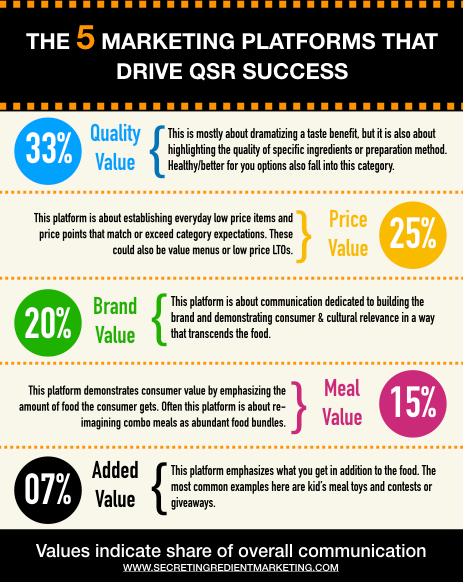|
There is an old saying among marketers that goes like this; “we can do whatever we want, we just can’t do everything we want.” Most QSR brand managers I know spend a lot of time agonizing over their marketing calendar trying to figure out which promotions to pursue and which to leave behind. They are constantly trying to optimize their marketing dollars to keep their brand healthy, their customers happy and sales as high as possible. Back in 2012 and again in 2019, Secret Ingredient Marketing studied the QSR category in great detail in an effort to understand QSR marketing dynamics and establish guidelines that brands can use to guide promotion calendar planning. Each time, we studied marketing communications from the 10 largest QSR brands in the US over a 12 month period. We took a total market approach that looked at regional and national efforts as a whole. In total, we looked at over 2000 ads (digital, print and TV). Our analysis revealed that marketing communications from these 10 QSR brands can be categorized into FIVE unique marketing platforms that provide unique consumer value. 1. Quality Value Platform: Marketing communications in this area are all about the food. The quality and taste of the food is the marketing story. Often this is about dramatizing a taste benefit, but it is also about highlighting the quality of specific ingredients or preparation method. Healthy/better for you options also fall into this category. 2. Price Value Platform: Efforts in this area are all about communicating a low price point. It’s about establishing everyday low price items and price points that match or exceed category expectations and serves the needs of a brand's most price sensitive consumers. These could be value menus, low price LTOs, low price combos, etc. 3. Brand Value Platform: While every marketing effort should feel well branded with a distinctive brand voice, this platform is about communication dedicated to building the brand and demonstrating its consumer and cultural relevance in a way that transcends the food. 4. Meal Value Platform: This platform is a close cousin to Price Value but differs in that this is more about communicating the amount of food you get for the money rather than the price itself. Often this platform is about re-imagining combo meals as abundant food bundles. This platform demonstrates consumer value by emphasizing the amount of food the consumer gets. 5. Added Value Platform: We call this the Added Value Platform because it emphasizes what you get in addition to the food. The most common examples here are kid’s meal toys and contests or giveaways. While not every brand uses Added Value initiatives, when used correctly it can be a good way to build traffic around a day-part, boost sales of core products or capture seasonal business. Now that we have identified the key platforms that create consumer value and drive marketing in the category, the next question is how much promotion should each of these platforms get? Is one platform more important than the others in terms of driving sales success? Is there an ideal mix of platform support that a brand should pursue over the course of a year? To answer this question, we studied the marketing behavior of QSR sales leaders and sales laggards. The Sales Leaders For sales leading brands, the lion’s share of the communication (31%) went toward the Quality Value platform. These brands seem to recognize that selling the quality or taste of the food is the most important thing to do. The next most important initiative was Price Value. Twenty-two percent of all communications were related to communicating a compelling price. Twenty one percent of all communication was dedicated to creating Brand Relevance through dedicated brand advertising. The Meal Platform was the next most important initiative with 17% of communications related to this category. And finally, just 9% was about promoting Added Value offerings. The Sales Laggards Not surprisingly, the marketing behavior of sales laggards looks very different from sales leaders. Sales laggards put 45% of their effort toward Price Value and another 29% toward Bundled Meal deals. Only 12% of sales laggards efforts went towards a Quality message. Laggard brands dedicated a whopping 28% of their efforts to Added Value initiatives. QSR Marketing Best Practice? So, what can we learn from this analysis? First, we learn that quality and taste focused marketing communications seems to be a key to sales success. For a brand to be successful, it must continue to appeal to the appetites of its customers. Whether it be introducing exciting new tastes & textures, finding appetizing ways to sell the old favorites, highlighting better for you options or articulating quality preparation methods, smart brands will make the Quality Value platform their #1 concern. Brands would be wise to dedicate at least one-third of their marketing efforts to promoting food quality. But, that’s not the only thing that matters. While quality should come first, promoting Price Value is also important. With the encroachment of Fast Casual, on Fast Food’s turf, it is a good idea to reinforce QSR’s Price Value advantage over Fast Casual and appeal to the needs of price sensitive fast food eaters. However, too much Price Value advertising can be counter-productive. It seems reasonable to keep these efforts in the 20-25% range, but nothing higher. Perhaps the most overlooked and controversial part of most QSR brand’s marketing mix is dedicated brand advertising. Ad Agencies often say that brand advertising should be first on the list and clients often want to put it last. Turns out they may be both right. This analysis suggests that a significant effort toward promoting brand relevance is important to sales success, but is not the only thing. To be successful, QSR brands need to find a way to build brand relevance in a way that transcends the food. But this works only if there is sufficient taste/quality promotions in place. So, dedicating 20% of your marketing effort toward the big brand does not seem excessive. The importance of Meal Value seems unclear with no clear difference between leaders and laggards. Still, it seems true that traditional combo meals are successfully being reinvented as box meals, party boxes and home meal replacement with an emphasis on abundance. The notion of getting a whole lot of food for not a lot of money has proven successful. Targeting “big eaters” with compelling meal solutions seems like a good idea and keeping these promotions to around 15% or less seems about right. Finally, this study seems to suggest that a small amount of good old fashioned sales promotion tactics can help drive sales during slow periods, breathe sales life into core products or help steal transactions from competitors during the busy months. Done correctly, it can also add value to the brand. If giveaways and contests feel right for your brand, then by all means do them. But do them sparingly with no more than 10% of your efforts going in this direction. Concluding thoughts
So, what do you think of this assessment? Does it fit your brand’s marketing model? Are these “best practices” worth pursuing? Our view is that this model is a good starting place, but does not explain all that QSR marketers need to know to be successful. There is more to QSR sales success than a well-managed promotional calendar. Even within each of the 5 value platforms, there is much deeper knowledge that can be shared. It’s one thing to identify Quality Value as an important platform, it is quite another to know how to execute effectively within that area. If you would like some help getting your sales moving up, please send us an email or give us a call. We would love to hear from you.
0 Comments
Leave a Reply. |
Details
AuthorDavid is a food marketing & advertising consultant and entrepreneur who has led the development of highly effective, award winning integrated marketing plans and innovation solutions for a broad range of food & beverage brands. As an industry thought leader, David has been a featured speaker at marketing conferences and a contributing author to important publications like ADWEEK and VentureBeat. ArchivesCategories |


 RSS Feed
RSS Feed
